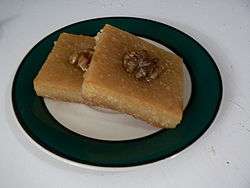Basbousa
|
Basbousa topped with walnuts | |
| Type | Dessert |
|---|---|
| Place of origin | Egypt |
| Region or state | Middle East, Horn of Africa, the Balkans |
| Main ingredients | Semolina or farina, syrup |
|
| |
Basbousa (Turkish: revani or ravani, Egyptian Arabic: بسبوسة) is a native Egyptian and traditional Middle Eastern sweet cake.[1] It is made from cooked semolina or farina soaked in simple syrup.[2] Coconut is a popular addition. The syrup may also optionally contain orange flower water or rose water.
Names
Basbousa has many regional and dialect names (Arabic: بسبوسة basbūsah, هريسة harīsa, and nammoura (in Lebanon[3]), Armenian: Շամալի shamali, Turkish: revani or ravani (from Persian[4]), French: gabelouze, kalbelouz, and qualb-el-louz (in Tunisian French), Greek: ραβανί and ρεβανί).
It is found in the cuisines of the Middle East, the Balkans and the Horn of Africa under a variety of names. In southern Greece, it is called ravani, while in the north, it is called revani. Basbousa is often called "hareesa" in Jordan, the Maghreb, and the Egyptian city of Alexandria. Basbousa is a particularly popular dessert among the Egyptian Coptic Christians for fasts, such as Great Lent and the Nativity Fast as it can be made vegan.
In Israel, a variety of the dish flavoured with yogurt, honey and spices is popular in Shavuot
Pastūsha
Pastūsha (sometimes stylized as Pastūçha) is a variant of basbousa that originated in Kuwait in the 2010s. Like basbousa, it is made from semolina soaked in sweet syrup. It is characterized by the addition of finely ground pistachios and orange flower water.
See also
References
- ↑ [http?id=FJxlWwrVcKcC&printsec=frontcover#v=onepage&q&f=false The Recipes of Africa] Check
|url=value (help). p. 241. Retrieved 2014-07-18. - ↑ "Arabic Dessert".
- ↑ "Taste of Beirut: Citrus muffins (Nammoura)". Archived from the original on 2014-07-21. Retrieved 2014-07-18.
- ↑ "Nishanyan - Turkish etymological dictionary: Revani (in Turkish)". Retrieved 2014-07-18.
- Alan Davidson, Oxford Companion to Food
